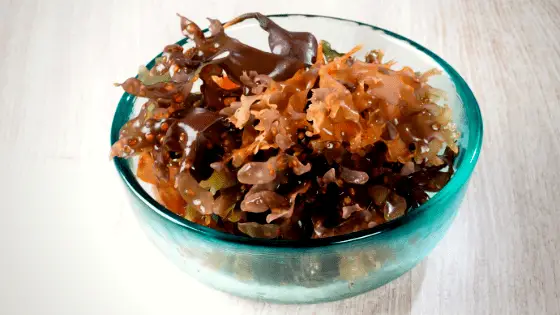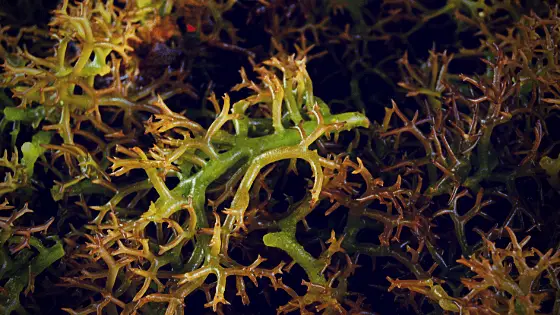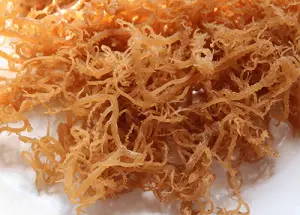Sea Moss Benefits & Side Effects
Sea Moss Benefits & Side Effects: A Complete Guide

When you buy through links on our site, we may earn an affiliate commission at no additional cost to you (learn more)
Sea moss has grown on the planet for millennia, and it has been used by the human race for thousands of years. Considered to be a red seaweed, it is an alga that largely grows in bodies of salt water. Sea moss has uses in its whole form, but its derivatives have also proved to be beneficial both on industrial and general healthcare levels.
Sea moss has helped to bolster many economies, including those of the cosmetic, pharmaceutical, and food industries. With functions ranging from serving as a thickening agent in countless food products to serving as an ingredient in skin care products to being used in topical treatments for various ailments, its uses are surely diverse.
Let’s take a look at what sea moss is, where it comes from, what its various uses are, and how it is beneficial to our health.
What is Sea Moss?
Sea moss falls under the plant kingdom but is technically considered an alga (singular form of ‘algae’). It is safe, however, to call this organism ‘seaweed.’ As the name would suggest, sea moss naturally grows in bodies of salt water. It provides habitat for many other organisms and serves as a source of food for grazers.
What Does Sea Moss Look Like?

This aquatic organism itself is a cartilaginous alga that is often a deep purple or red color when found in water; it also presents in a yellow-color, with varying shades in all ranges of these mentioned colors. When washed upon shore, the moss turns white due to a bleaching process from the sun. The texture of its leaves can be described as flat, gummy or rubber-like, and crimped.
Each plant can grow up to six inches tall and four inches wide. Variations in the presentation of the plant are affected by the depth of water in which it is growing and the salinity of that water. For commercial uses, such as in the food, pharmaceutical, or cosmetic industries, sea moss has traditionally been harvested when it is 3 to 5 years of age.
What are the Growing Conditions for Sea Moss?
This alga can grow in very shallow waters and in a depth up to 20 meters below the surface of the water. Variables that affect its growth in any water include wave activity (gentle vs. harsh waves, for example), opacity of the water for purposes of sunlight exposure, and the type of surfaces that are available.
Sea moss often clings to rocky surfaces and structures, and is, accordingly, often found coastally. Areas where it thrives most abundantly do not have a lot of sediment, dirt, or small rocks, but instead feature large rock formations. It is also known to grow well in tidal pools. When the environment is adequate, the moss grows thickly and abundantly, forming somewhat of a sea-moss sea carpet! Like many other plants and algae, the best growing season of sea moss is in the spring and summer months. However, sea moss can survive freezing temperatures as it is a hardy alga.
Where in the World Does Sea Moss Grow?
The moss is largely found in the coastal areas of the North Atlantic, both on the Eastern and the Western sides of the water body. Per one of its common names, this subaquatic organism is found in the waters around Ireland and has been used by the Irish for many purposes, even for consumption in times of famine and for medicinal purposes. Cultivation has been attempted in other areas throughout the world, such as Mexico, but the plant continues to thrive most naturally in the aforementioned locales.
What is Sea Moss Used For?
Sources cite the seaweed industry of having an annual value ranging in the billions of dollars – 5.5-6 billion dollars, to be exact. A large percentage of this value relates to products that are made for human consumption; a smaller percentage is attributed to the use of seaweeds for making hydrocolloids (substances that help to thicken liquids), and the rest is attributed to use of seaweed as additives in fertilizer or animal food.
Sea moss used for industrial purposes can be harvested from natural sources straight from the ocean; this type is considered to be ‘wild’ seaweed. Conversely, and with increasing popularity today due to efficiency and cost reduction, sea moss can also be grown and cultivated, with this type being known as ‘farmed’ seaweed. Because demand has surpassed the quantity that Mother Nature is able to supply in her coastal regions around the Northern parts of the Atlantic Ocean, cultivation has become widespread throughout the world and the moss can now be harvested in many different climate zones in both hemispheres.

Sea moss has historically been harvested for two main purposes: For use as a food and for one of its derivatives, carrageenan. Carrageenan has a diverse array of uses in each of the food, pharmaceutical, and cosmetic industries. In the food industry, it is used to thicken different items such as soups, jellies, and candies. Pharmaceutically, it has reported early uses for breathing issues in Ireland. It was also traditionally used for feeding pets and livestock in Nordic countries.
Another use for sea moss is as a fertilizer. Use for this purpose dates as far back as the nineteenth century and was used as such by people inhabiting coastal lands. The high fiber content of the sea moss would help create a soil with body and good air dispersion that would hold moisture well. And since the moss was from the sea, it would also provide the soil with important nutrients and trace elements.
With the invention of artificial fertilizer, however, this practice slowly subsided. But in recent years, it has made a comeback in some groups that are seeking organic means of fertilizing plants, in line with current trends to cut down on pollution and use of chemicals in the food system. Use is restricted, though, as production of sea moss for use as fertilizer is time-consuming and really only accessible to those in nearby warmer climates where the moss is grown.
What is Carrageenan?
The main derivative from sea moss that is used most widely, carrageenan is a carbohydrate that, when dissolved in water, works to thicken the water. This substance can be used to achieve varying levels of thickness in a solution and has been used to create gels, films, and for product stabilization. For example, carrageenan is often found in ice cream; it serves to prevent water molecules from sticking to each other and forming large crystals, help to keep the ice cream soft and creamy.
Use of carrageenan extracted from sea moss dates back to the nineteenth century, and use of the moss on the industrial level skyrocketed after World War Two. Since then, close study of sea moss and the determinants for its best growth have allowed for widespread cultivation. These efforts now attribute for a majority of the provision of carrageenan for industrial use throughout the world.
Carrageenan in the Food Industry

The food industry makes up the largest demand for carrageenan, with the dairy industry being the largest user in this subset. It is used in cottage cheese and ice cream to prevent milk solids from separating out from the liquids, in chocolate milks and milk powders to prevent the cocoa from separating from the milk and to give a pleasant mouthfeel, and in whipped creams to help keep the air evenly distributed throughout the cream, among other uses.
Use of carrageenan to thicken water-based foods, such as jellies, has increased in popularity with the movement to get away from using animal products (mainly gelatin, in this case). The animal-based gelatin has some perks to its use, mainly that it affords a pleasant flavor on its own, it melts at body temperature, and is smooth in consistency. However, these gelatins do toughen unpleasantly after a couple days, an occurrence that is avoided with the use of carrageenan-based jellies. Another benefit of using carrageenan-based jellies is that they don’t melt as easily, making them easier to use in warmer climates.
In the meat industry, solutions are often injected into products that are going to be sold as pre-cooked items. These solutions usually consist of a brine made of water, salt, phosphate, and carrageenan. The purpose of using this brine is to create a final product that is juicy, has a higher yield, and is more appealing to the consumer. The carrageenan specifically works by helping to retain the water that is found within the muscle of the given animal products, preventing losses when cooking, and providing a more tender product for the consumer.
Sea Moss in Cosmetic and Healthcare Products
Sea moss has applications for cosmetic and pharmaceutical uses. Check the labels on your creams and lotions and look for phrases such as ‘marine extract, ‘extract of alga,’ or ‘seaweed extract;’ these phrases indicate that a seaweed has been used in the creation of this product. Carrageenan is often used in cosmetic products such as creams or lotions to help the product better retain moisture in the skin of the person using said product.
Sea Moss for Skin and Topical Uses
They are also claimed to increase elasticity and softness of skin. Other products are said to help bring relief to those suffering from osteoporosis or rheumatism; in these products, seaweed is ground into a paste, rubbed onto the body, and heated. Use of seaweeds in this manner has also been cited to remove cellulite; however, research has not substantiated the effectiveness of use for this purpose.
Sea Moss for Hair
Sea moss is also used in products to help improve the health of your scalp and hair. Benefits include increasing gloss and shine in hair, increasing body and volume of hair, and providing relief for irritated or dry skin on the scalp.
Sea Moss for Mucus
Our bodies use mucus for several reasons. They provide a barrier that helps to protect us from pathogens that are found naturally in the environment, on our skin, and within our bodies such as in our nasal passages, or lungs, or our digestive tract. When a pathogen does find its way into our system, in some cases our bodies use mucus to form phlegm to rid the body of the mal-intentioned microorganism. Forming a gel when wet, and being a good source of omega-3, chlorophyll, and potassium chloride, sea moss is purported to be a good agent when used for the purposes of helping to dissolve mucus. It has also been purported to help maintain the mucus found in the lung and the gastrointestinal sytems, alike.
A Word of Caution
When choosing to use sea moss for health benefits, it is important to pay attention to where your sea moss is coming from. Sea moss works as a filter in the ocean and, accordingly, can acquire large amounts of heavy metals such as mercury and lead. Some shorelines have not been certified as not containing these metals, which can be hard to do. The ocean is quite contaminated from oil spills, garbage dumps, and general mistreatment. For this reason, it is recommended to seek out organic sea moss when possible.
How to Use Sea Moss for Health
Sea moss can be eaten, taken as a capsule, or used in cosmetic products such as creams, lotions, and rubs. For eating, try adding it to a smoothie. Because it is low in protein and fat but higher in carbohydrates, be sure to balance out your smoothie accordingly. The saltiness of this alga lends itself to being a good compliment to cooked dishes as well, especially when it is dried.
Conclusion
Sea moss is a wondrous part of nature. Having been used for centuries, it has helped provide nourishment in times of famine, bring relief to various medical ailments, and helped bolster entire industries. With all of this, it has also proven to be a good tool for helping to keep skin more supple and elastic, bring some shine to your hair, and act as a natural decongestant. Praise whoever discovered the wonderful creation and helped to bring it throughout the world!



